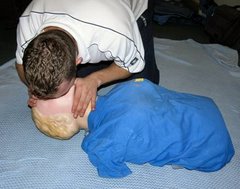Head Injuries 1: CONCUSSION
The brain is naturally cushioned in the skull by a surrounding fluid. If the head is suddenly or violently moved the brain if free to shake a little bit - this is concussion. Concussion is a common occurence on the sports field, traffic accidents, after falls or after being hit on the head.
This shaking produces a temporary disturbance to the normal brain activity. It doesn't normally result in long term damage, if recognised and treated correctly. Concussion may result in impaired consciousness, but this usually subsides quickly. Concussion can be confidently diagnosed when the casualty is seen to recover. A casualty who is concussed should be monitored and medical attention sought if they begin to vomit, develop a headache or blurred vision. A sports player who has suffered concussion should NEVER be encouraged to play on.
Recognition:
This shaking produces a temporary disturbance to the normal brain activity. It doesn't normally result in long term damage, if recognised and treated correctly. Concussion may result in impaired consciousness, but this usually subsides quickly. Concussion can be confidently diagnosed when the casualty is seen to recover. A casualty who is concussed should be monitored and medical attention sought if they begin to vomit, develop a headache or blurred vision. A sports player who has suffered concussion should NEVER be encouraged to play on.
Recognition:
- Impaired consciousness following a blow to the head. The casualty will appear to recover shortly afterwards.
- There might also be dizziness, blurred vision, headache or a loss of memory.
- To observe the casualty.
- Ensure a responsible person remains with the casualty until they recover.
- To obtain medical aid if there is any deterioration in the casualty's condition (see above).
- Monitor and record vital signs - level of response, pulse, and breathing. Even if the casualty appears to recover fully, watch them for subsequent deterioration in his level of response.
- When the casualty has recovered, place him in the care of a responsible person.
- Advise the casualty to go to hospital if, following a blow to the head, they later develop:
- headache,
- nausea,
- vomiting, or
- excessive sleepiness


